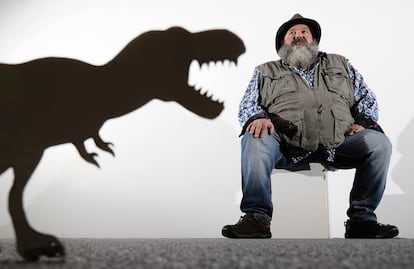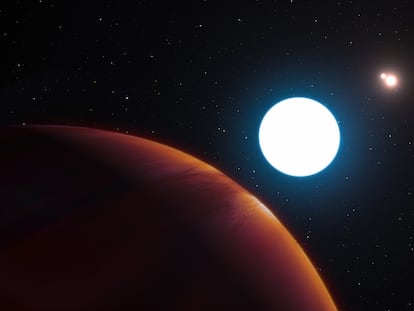Mark Loewen: ‘Dinosaurs are still the kings of the world’
The paleontologist explains the evolution of dinosaurs, which first appeared the size of a wolf and became extinct millions of years later after multiplying their height and strength

University of Utah paleontology professor Mark Loewen has been part of in the cataloging of 13 new dinosaurs. A specialist in Jurassic and Cretaceous dinosaurs, he forms part of the scientific team at the Utah Museum of Natural History. This April, he came to the Granada Science Park to speak about dinosaurs, the “predominant predators of their ecosystem,” whose first specimens “were no bigger than a wolf” and reached the size and strength of the T. rex in the Jurassic Park movies. He specializes in the taxonomy, evolution and biogeography of carnivorous, armored, and horned dinosaurs.
Question. Why is it important to research dinosaurs and why are they important today?
Answer. Dinosaurs are really amazing because they lived for such a long time. At the same time, dinosaurs were masters of their ecosystems. They were the dominant animal in all of the ecosystems that they lived in. Understanding how dinosaurs dealt with the changes in their ecosystems is actually informative to us today in how our world is changing, to understand the results of how the world changes and what impact that has on animals and plants and communities living today. When dinosaurs started out, they weren’t major players in their ecosystems. But they managed to survive multiple extinction events and become the most dominant predator in every ecosystem. The world was dominated by dinosaurs from at least from 200 million years ago to 66 million years ago, and yet they appeared as small, fox-sized animals that walked on two legs.
Q. How much time passed from that small animal to the great saurians?
A. Different dinosaur groups appeared along at different times. But dinosaurs almost certainly evolved by 240 million years ago. The oldest dinosaurs we have are from 232 million years ago in Argentina. At that time there were at least three of the seven different groups. The ceratopsians didn’t show up until about the same time as birds, which is somewhere around 160 million years ago.
Q. Are there dinosaurs today?
A. Of course: the birds. There are between 8,000 and 12,000 species of birds for which we have names, but there are studies that speak of between 18,000 and 20,000 species of living birds. Birds far outnumber mammals, so we can say that dinosaurs are still kings of the world today.
Q. So why do we consider them extinct?
A. Because we only recently understood where the birds came from. Since we have found feathered dinosaurs, we can already conclude without a doubt that all birds came from carnivorous dinosaurs.
Q. Is there a single dinosaur from which birds came?
A. The usual answer is that velociraptor and troodontids are the common ancestor of today’s birds. There were birds that lived with the dinosaurs, some with claws on their wings, with teeth. They all became extinct, and only the toothless birds we know of survived.
Q. What animals can we then consider dinosaurs beyond the stereotypes of T. rex or those dinos with long necks?
A. Generically, I would say that we can think of dinosaurs as those animals with big teeth and big bones that we imagine. Birds are a specific and specialized group within the dinosaurs, the largest carnivorous animals that have ever existed on earth.
Q. Did dinosaurs ever coincide with any predecessor of modern humans?
A. No, absolutely not. All the dinosaurs we think of as such became extinct 66 million years ago, and birds evolved alongside mammals, from which primates later emerged.
Q. Are they as fierce as we see them in the movies?
A. Even more. A Tyrannosaurus rex could grab animals, tear them apart and swallow them whole, just like that, bones and all.
Q. In March the discovery of some new species of Tyrannosaurus rex was published, but the scientific community has doubts due to the lack of specimens found. What do you think?
A. This research speaks of three species of T. rex, determined from measurements of the bones of the legs. As somebody who’s measured thousands and thousands of leg bones, I’m not completely convinced on the data that used to suggest three different species. There may be more than one species, but I don’t think that the criteria that they used species is true. If there are 2 million years in which the T-Rex lived, almost certainly there are different species. The criteria they use are changes in the teeth and the lower jaw, and then changes in the thickness of the femur. They don’t have enough specimens of the leg bones to convince me personally.
Q. How many specimens would it take to find a new species for sure?
A. If we want to define it only from differences in the thickness of the leg bones, at least 50 specimens. I expect there to be changes that we can see in the skull, and that’s one of the problems with this study. Paleontologists who study taxonomy recognize changes in the skull as the real changes between species. If you can’t tell the difference in the skull of the animal, I’m more skeptical. They had little differences in the teeth at the front of the snout, but not very many specimens. But I am convinced that there is more than one species of T-Rex, based on characteristics of the skull and the body measurements.
Q. What was the geographic distribution of Tyrannosaurus rex?
A. We’ve only found it in a swath of western North America, from Texas to Canada. Basically, in the Rocky Mountains.
Q. Will they be found elsewhere?
A. I wouldn’t be surprised to find them on the east coast of North America, but I don’t expect them, for example, in Europe. Pangea split the world apart into a bunch of islands. In what would later become the United States, T. rex, triceratops and ankylosaurs all evolved, a lot of it because there were many different environments for change to happen. The T. rex could not get to Europe because it would have had to cross the Bering Strait.
Q. When was it discovered that dinosaurs have feathers?
A. We only found out that dinosaurs had feathers in 1996, and we’re still finding different groups of dinosaurs with feathers. Not every dinosaur did have feathers, but it’s now clear that any dinosaur had the potential to have feathers.
Q. Where did they have them and what did they use them for?
A. On the arms and along the spine, from the head to the end of the tail. And they definitely weren’t for flying. It has been suggested that they were to regulate body temperature, but the placement of the feathers, from the top of the head down the spine, is more consistent with competition for mates, to impress members of the same species. So we think of it as a sexual selection characteristic.
Q. In this type of research, about what happened millions of years ago, what is fantasy or imagination and what is scientific truth?
A. When we have bones, we can take the bone and look at scarring on the bone to reconstruct the soft tissue that isn’t present anymore. We can faithfully reconstruct what it was like, for example, the claw of a dinosaur. We can look at the long bones of an animal and we can reconstruct the muscles that connect them. We have done that by looking at alligators and looking at chickens and dissecting them. If a crocodile and a bird have a soft tissue and you can find the evidence on modern bones, you can safely infer that onto ancient bones that have the same marks. From there, with computer models, you can figure out how it all works. As you go further and further away from the bones, you’re inferring more and more and more. But we’re always trying to use modern animals as analogues to constrain the science. Then some data, such as T. rex being a scavenger, arises as a fantasy from some real data. Today, however, paleontologists are certain that he was also a hunter. In fact, he was a hunter and a scavenger. No animal that hunts today will pass up a free meal.
Q. As a science communicator, what role do the Jurassic Park movies play in understanding these animals?
A. Incredibly important. They really have had effects on getting paleontologists excited about studying paleontology. I myself was a geologist when these movies came out and, although not exactly because of them, here I am now, researching dinosaurs. II got interested in how ecosystems started working and as a geologist I transitioned into looking at the fossils more than the sediments, and then that led to looking at dinosaur ecosystems. At the same time, the Jurassic Park franchise has been important for funding as people get interested in dinosaurs. Then they start thinking that maybe we should fund science to look at that.
Tu suscripción se está usando en otro dispositivo
¿Quieres añadir otro usuario a tu suscripción?
Si continúas leyendo en este dispositivo, no se podrá leer en el otro.
FlechaTu suscripción se está usando en otro dispositivo y solo puedes acceder a EL PAÍS desde un dispositivo a la vez.
Si quieres compartir tu cuenta, cambia tu suscripción a la modalidad Premium, así podrás añadir otro usuario. Cada uno accederá con su propia cuenta de email, lo que os permitirá personalizar vuestra experiencia en EL PAÍS.
¿Tienes una suscripción de empresa? Accede aquí para contratar más cuentas.
En el caso de no saber quién está usando tu cuenta, te recomendamos cambiar tu contraseña aquí.
Si decides continuar compartiendo tu cuenta, este mensaje se mostrará en tu dispositivo y en el de la otra persona que está usando tu cuenta de forma indefinida, afectando a tu experiencia de lectura. Puedes consultar aquí los términos y condiciones de la suscripción digital.
More information
Últimas noticias
Most viewed
- Reinhard Genzel, Nobel laureate in physics: ‘One-minute videos will never give you the truth’
- Oona Chaplin: ‘I told James Cameron that I was living in a treehouse and starting a permaculture project with a friend’
- Pablo Escobar’s hippos: A serious environmental problem, 40 years on
- Charles Dubouloz, mountaineering star, retires at 36 with a farewell tour inspired by Walter Bonatti
- Why we lost the habit of sleeping in two segments and how that changed our sense of time











































